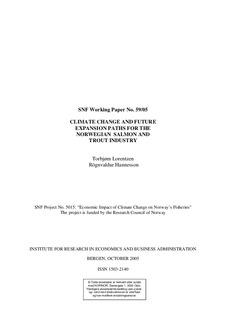Climate change and future expansion paths for the Norwegian salmon and trout industry
Working paper

Åpne
Permanent lenke
http://hdl.handle.net/11250/165430Utgivelsesdato
2005-10Metadata
Vis full innførselSamlinger
- Working papers (SNF) [809]
Sammendrag
Global warming is expected to affect the ecosystem in the Northeast Atlantic, and sufficient changes will also affect the aquaculture industry. Farming of salmon and trout is the biggest aquaculture industry in Norway. The first hand value was about 10 billion Norwegian kroner (about 2 billion US dollar) in 2004. The Norwegian salmon industry is the world’s largest producer of Atlantic salmon – and the production potential has still not been fully utilized. About 2500 persons are directly employed in the industry.
The analysis shows that the extensive allocation of licenses for aquacultural production has reduced the number of suitable, vacant areas for farming in especially coastal areas off Agder, Rogaland, Hordaland and Nord-Trøndelag. The future expansion will mainly take place in the areas north of Stadt.
We anticipate that the salmon aquaculture industry will be relocated from the south to further north along the coast, partly because vacant areas are in the north and partly because higher sea temperature in the future could make the southernmost coast (Vest Agder, Rogaland and Hordaland) unsuited for farming of salmon.
In the short run (5 yeas or so) the production will increase in the already established firms located along the coast, from today’s 600,000 tons to 800,000-900,000 tons. An econometric model shows that an expansion in existing plants will increase the gross revenue by about 2 billion Norwegian kroner per year. Expansion beyond 900,000 tons must therefore be produced in new plants. We have estimated the production potential from new plants to about 1.2 million tons. We calculate that the aggregated, future production potential is about 2.1 million tons (0.9 + 1.2) of salmon and trout per year, given no “extraordinary” climate changes. On the other hand, if the sea temperature continues to increase, it could in the worst case make it too risky to farm salmon in open cages in the sea off Vest Agder, Rogaland and Hordaland. The said areas will then lose a yearly aggregated production of about 240,000 tons. An overall future increase in the sea temperature will increase the productivity in the industry located north of Stadt. The combination of full utilization of vacant areas north of Stadt and increased productivity there, but radical reduction in the three southernmost counties, would result in a future aggregated supply of about 2 million tons of Norwegian salmon per year.
The econometric analysis shows that there is a long run negative relationship between export prices and quantity supplied of Norwegian salmon. The negative relationship between price and quantity (elastic demand) indicates a potential of realizing extra profit in the export market by restricting the supply. The partial model does not take into account that increased supply from competing salmon producing countries can undermine the quantity restriction strategy.
Utgiver
SNFSerie
Working Paper2005:59